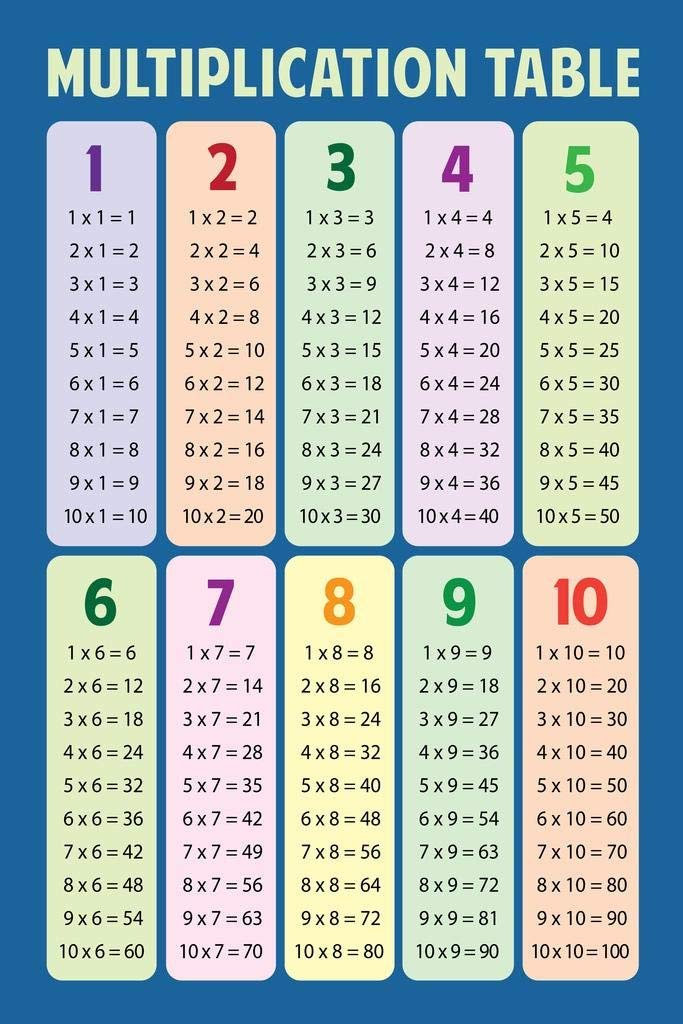How to learn the multiplication for 4th grade table quickly.
We do not find the multiplication table very difficult, but it is just the opposite for the child. Adults need to help their schoolchild a little to simplify the task and make it more interesting to study.
Now the multiplication table is taught in the second grade, and it is often asked to be taught in the summer. If your child has not learned so far, our advice will help you learn the multiplication table quickly and in a playful way.
Multiplication for 4th grade table is necessary

History
Have you ever wondered who invented the multiplication table?
Many people call the multiplication table “Pythagoras Table”. And they think that Pythagoras was its founder, but there’s no direct evidence of that. Scientists’ opinions are divided.
In school, the first multiplication table was introduced in medieval England, multiplied numbers to 12. And it’s been preserved to this day. By the way, in India, the table includes numbers up to 20.
The oldest multiplication table (up to 10) was found during excavations in China about 305 B.C. Also in Japan, a fragment of the plate with records of multiplication of numbers was found during excavations. Multiplication for 4th grade table.
But there is another version that the multiplication table is from Mesopotamia. On excavations of ancient Babylon found a table with the age of about 4000 years with hexadecimal system of calculation.
The table appeared thanks to the mathematician Leontius Filippovich Magnitsky, in 1707.
Where to start and how to teach. Tips for parents:
- Explain that multiplication is necessary to simplify and speed up calculations, children should understand why it needs to be taught at all;
- hang the multiplication table in a prominent place in your child’s room;
- explain the principle:
For example: 2×4 is the same as 2+2+2+2 or 7×3 is the same as 7+7+7, etc.
- show the patterns of the table;
- introduce the child to the Pythagoras table and its device. When you multiply the numbers at their intersection, you get the correct answer;
- do not learn by much;
- repeat more often in order and in different ways;
- do not force the child, try to entrain;
- do not swear, if something does not work, perhaps the child needs a little more time to remember, be patient;
- praise the child for success;
- put multiplication into practice. For example, at home you have a box of sweets consisting of 3 rows and in each row of 5 sweets. How can you quickly count all the candies? Of course, the multiplication table 3×5=15 will help.
Let’s find out the patterns.
100 in 28 examples.
In the multiplication table of 100 examples, the child thinks it’s a lot and can learn it all summer. But 100 examples can be reduced to 36, and the Pythagoras table will help.
Invite children to fill in the Pythagoras table themselves:
It won’t be difficult for the child to fill it, even if he’s not familiar with multiplication yet.
By filling in the table, you can see the regularities. For example, that the numbers are repeated. And by applying the moving multiplication property (which means that 5×8 is the same as 8×5), you can reduce the table to 55 examples. We also see that: when multiplying by 1, there is also a number, when multiplying by 2, it doubles, when multiplying by 10, there is zero at the end. And in the end, you need to remember not 100, but 28 examples.

There are also regularities:
- all the answers in examples multiplied by 5 end with 5 (if the odd is 7×5=35) or 0 (if the even is 6×5=30).
- when multiplied by 4, double the number. For example: 8×4, which means 8+8=16 and 16+16=32.
- when multiplying by 9, you can apply the following pattern: multiply by 10 easily, just add 0, 4×10=40, and when multiplying by 9, the answer is less by the number by which we multiply 40-4=36, so 4×9=36.
- The answers in the examples multiplied by 5 are half as many as the answers multiplied by 10. For example: 8×10=80, а 8×5=40.
How else can you learn
From a psychological point of view, people are divided into audiovisuals (well memorized by hearing), visuals (memorized by visual image) and kinestics (memorized by feelings, feelings). Observe your child and find out which way is best for them.
Audiences:
1.Poems
2.Children’s songs
Visuals:
- Teaching cartoons.
- Bright tables on the wall with figures and numbers.
- Multiplication table in coloring.
Kinestics:
1.1 You can study the multiplication table using the cards with the numbers shown on them. Children can make up their own examples.
2.Study on the fingers.
Multiplication table by 9 (just in the cartoon about locks shows this method).
- Keep your hands in front of you, palms looking down.
- Let’s imagine that each finger has its own number. The little finger on the left hand will be first, on the right hand 10, the rest in order.
- We try to multiply by examples: 5×9.
Bend the finger that was mentally your fifth.
- The number of fingers to the bent finger shows dozens in the answer, in our case it is 4 fingers = 40.
- The number of fingers on the right will show the units. In our case it’s 5.
- 40+5=45 and 5×9=45
Also workbooks for 4th grade.
Recent Comments